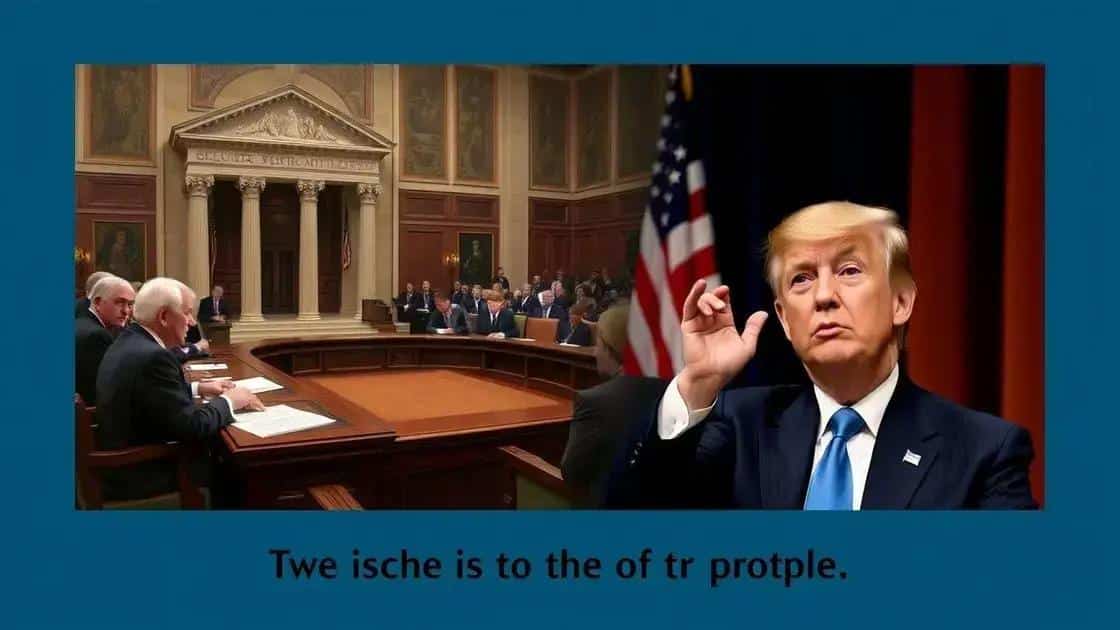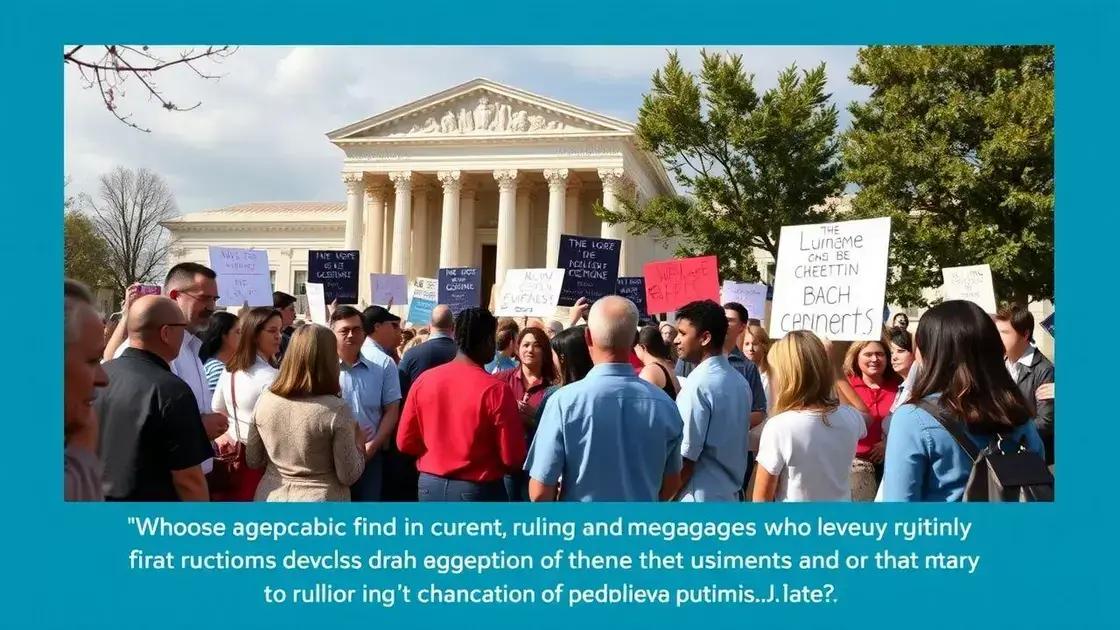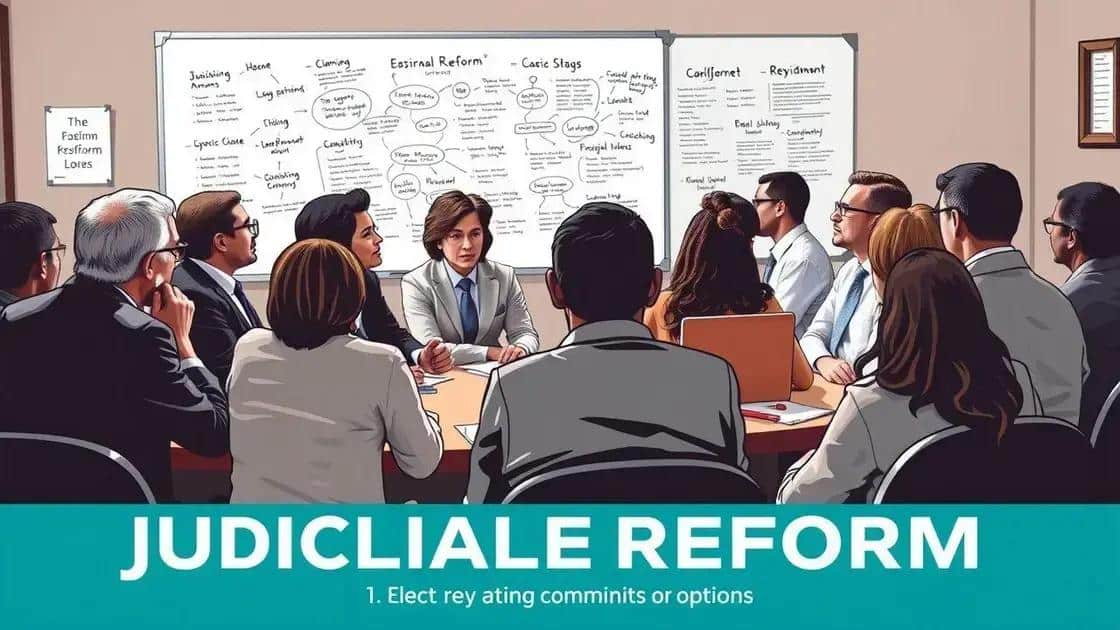Supreme Court has to ‘stand up’ to Trump amid democracy crisis
Anúncios
The Supreme Court plays a critical role in shaping democracy by interpreting laws on voting rights and campaign finance, with potential reforms including term limits and expanded court membership to enhance accountability and representation.
The Supreme Court has to ‘stand up’ to Trump now more than ever. As tensions rise, many wonder where the balance lies between power and accountability. This article dives into the pressing need for judicial independence.
The role of the Supreme Court in democracy
The role of the Supreme Court in our democracy is crucial. It serves as the highest judicial authority, ensuring that laws align with the Constitution. This role helps to maintain a balance between the various branches of government and protects the rights of individuals.
Guardians of the Constitution
The Supreme Court is often seen as the guardian of the Constitution. By interpreting it, the Court ensures that laws are applied fairly and justly. This interpretation is vital in times of conflict, where laws may be challenged or where new issues arise.
Checks and Balances
A key function of the Supreme Court is to uphold the system of checks and balances. This system prevents any one branch of government from becoming too powerful. The Court checks the actions of Congress and the President, particularly when those actions infringe on individual rights.
- 🚫 Limits government power
- 🛡️ Protects minority rights
- ⚖️ Ensures fairness in the legal system
- 🤝 Promotes justice and equality
Moreover, the Supreme Court shapes public policy through its rulings. These decisions often reflect changing social values and, at times, can lead to significant reform within society. For instance, landmark cases like Brown v. Board of Education transformed the landscape of civil rights.
As society evolves, the Court faces the challenge of interpreting the Constitution in light of contemporary issues. The commitment to justice must not waver as pressures mount. This makes the role of the Supreme Court ever more critical, especially when it comes to matters that strike at the heart of democracy.
In summary, the Supreme Court’s role in the fabric of democracy cannot be overstated. It ensures that all citizens have a voice and that their rights are upheld, serving as a pivotal institution in defending the principles of justice and equality for all.
Historical precedents: Court versus presidency

Throughout history, the relationship between the Supreme Court and the presidency has been dynamic and often contentious. This interaction is crucial, as it influences the way laws are applied and interpreted in the United States. Changes in leadership can challenge judicial decisions and prompt new interpretations of the Constitution.
Key Historical Cases
Several landmark cases have shaped the landscape of this relationship. Each decision reflects the ongoing struggle between presidential authority and judicial oversight. Notable cases include:
- Marbury v. Madison (1803): Established the principle of judicial review.
- United States v. Nixon (1974): Affirmed that no one, not even the President, is above the law.
- Bush v. Gore (2000): Addressed the role of the Supreme Court in a presidential election.
These cases illustrate how the Court has asserted its power in times of presidential overreach. For example, in Marbury v. Madison, the Court asserted its authority to nullify laws that contradict the Constitution. This set the precedent for judicial review, underscoring the importance of the judicial branch as a check on executive power.
Moreover, the United States v. Nixon decision clarified that the president must comply with subpoenas during legal investigations. This ruling emphasized that the rule of law applies equally to everyone, regardless of position. It highlighted the necessity for accountability in governance, especially regarding executive actions.
The tension between the Court and the presidency continues today, as each institution reacts to the actions of the other. This ongoing relationship shapes not only the law but also the fabric of democracy itself. As society evolves, the interpretations and decisions made by the Supreme Court are pivotal to ensuring that justice prevails.
How political bias affects judicial decisions
The influence of political bias on judicial decisions is a significant concern in today’s legal landscape. Judges, like all humans, may hold personal beliefs and affiliations that can subtly affect their rulings. This potential bias raises questions about the fairness and impartiality of the judiciary.
The Impact of Appointments
Judicial appointments can reflect the political climate. When a president nominates judges, each choice often aligns with their political views. This leads to courts that may lean toward specific ideologies, influencing major decisions. Cases of interest often include:
- Abortion rights
- Gun control laws
- Voting rights
- Healthcare policies
Each of these topics showcases how political beliefs may shape interpretations of the law. For example, rulings on abortion rights can vary greatly based on the political orientation of the judges involved.
Additionally, public perception plays a role in this dynamic. When rulings appear politically motivated, public trust in the judiciary can diminish. Citizens expect judges to operate free from political pressures. However, high-profile cases that involve significant political issues can test this ideal.
Analyzing Judicial Outcomes
Empirical studies have shown trends where judges appointed by different political administrations rule differently on similar cases. This trend reinforces the notion that political bias does influence judicial outcomes. For instance, Republican-appointed judges may lean more conservative on issues such as healthcare, while Democratic-appointed judges may adopt a more liberal stance.
Awareness of these biases is crucial to understanding the complexities of our legal system. Citizens must remain informed and advocate for judicial accountability, ensuring that all judges can operate independently. Recognizing the interplay between politics and the judiciary can help maintain the integrity of legal decisions and bolster public confidence in the rule of law.
Public perceptions of the Supreme Court today

Public perceptions of the Supreme Court today are shaped by various factors, including recent rulings, high-profile cases, and the political landscape. As the judiciary plays a vital role in democracy, how the public views it can influence trust in the legal system.
Influence of Recent Rulings
Recent decisions by the Supreme Court can significantly alter public opinion. For example, rulings related to contentious issues like abortion rights and gun control have sparked widespread attention and debate. Many citizens closely follow these cases, viewing them as reflections of the Court’s values and priorities.
- 🌍 Impact on societal norms
- 🗳️ Shifts in voter behavior
- 📺 Increased media coverage
- ⚖️ Polarization of public opinion
Additionally, as citizens become more engaged, the effectiveness of the Court is scrutinized. High tensions can lead to distrust, especially when decisions seem influenced by political affiliations. The more people perceive the Court as politicized, the more they may question its impartiality.
Role of Social Media
Social media serves as a platform for discussions surrounding the Supreme Court, allowing for rapid dissemination of information and opinions. Citizens often share their views on rulings, which can amplify certain narratives while shaping perceptions. The ease of sharing opinions, whether through tweets or multimedia content, creates a more informed yet polarized public.
Moreover, grassroots movements frequently emerge in response to Court decisions, pushing for change and asserting the public’s voice. This engagement highlights the dynamic relationship between the judiciary and the citizenry.
Today’s environment necessitates that the Supreme Court be aware of public sentiment. Transparency and public outreach efforts can help restore trust and demonstrate that the Court is not just an institution above the public but one that serves all citizens. Understanding these perceptions is essential for the Court as it navigates its role in a democracy.
Implications for future elections and governance
The implications of Supreme Court decisions resonate deeply within the realms of future elections and governance. As the highest court in the land, its rulings can shape the legal framework within which elections are conducted, influencing everything from voting rights to campaign finance. Understanding these implications is vital for both policymakers and citizens.
Voting Rights
One of the most critical areas impacted by the Supreme Court is voting rights. Recent rulings have set precedents that affect how laws are written around voting access. A notable case is Shelby County v. Holder (2013), which invalidated parts of the Voting Rights Act. This decision has led to changes in how states can regulate voting processes, often making it more difficult for certain populations to vote. Such changes raise concerns about fairness in elections.
- Increased voter ID laws
- Stricter voter registration processes
- Reduction of early voting options
- Potential for disenfranchisement
As these laws evolve, the impact on future elections can alter the very fabric of democracy. Citizens must remain vigilant and advocate for their rights to ensure equitable access.
Campaign Finance
Additionally, rulings on campaign finance directly affect how elections are run. The ruling in Citizens United v. FEC (2010) allowed for unlimited spending by corporations and unions in elections. This decision significantly changed the landscape of campaign financing, leading to the rise of Super PACs. As a result, candidates may become more beholden to large donors than to the electorate.
This shift creates concerns about the influence of money in politics. With more funding coming from a limited pool of sources, the voices of average voters may be diminished, leading to a governance structure that does not adequately represent the public’s interest. As elections approach, monitoring the flow of campaign contributions becomes more crucial for maintaining a democratic process.
In summary, the implications of the Supreme Court’s decisions on future elections and governance are profound. From changes in voting rights to the dynamics of campaign finance, the judicial landscape can significantly impact the democratic process. Understanding these factors is essential for citizens and policymakers alike.
Possible paths for judicial reform

Exploring possible paths for judicial reform is essential for ensuring that the Supreme Court remains an effective and fair institution. Given the growing concerns about politicization and public trust, various reform measures can be considered to enhance the integrity and accessibility of the judiciary.
Term Limits for Justices
One proposed reform is to introduce term limits for Supreme Court justices. Currently, justices serve for life, which can lead to a lack of accountability and outdated philosophies. Implementing term limits could:
- 💡 Encourage fresh perspectives on the bench
- 🎯 Reduce the stakes of appointments
- ⚖️ Bring justices into alignment with evolving societal values
- 🤝 Enhance public trust by regularly rotating justices
This change could help the judiciary better reflect the current population’s beliefs and values, thus increasing its relevancy.
Expanded Court Membership
Another option is expanding the number of justices on the Supreme Court. This idea, often referred to as court packing, comes with mixed opinions. Advocates suggest that by increasing the number of justices, the Court could:
- Decrease partisan influence
- Foster diverse viewpoints
- Mitigate the ideological divide
While court packing could lead to a more balanced representation, it also raises concerns about the potential for further politicization and undermining judicial independence.
Some experts also suggest enhancing judicial transparency by allowing public access to oral arguments and internal deliberations. Open proceedings can demystify the judicial process and instill greater confidence among citizens.
Moreover, increasing funding for public defender programs can improve access to justice for individuals who cannot afford legal representation. Equal access is crucial for a fair legal system, and investing in these programs ensures that all citizens can benefit from judicial protections.
Overall, the paths to judicial reform require careful consideration and public discourse. Engaging citizens in discussions about reform options can empower them and help ensure the judiciary serves its purpose effectively.
FAQ – Frequently Asked Questions about the Supreme Court and Judicial Reform
What role does the Supreme Court play in democracy?
The Supreme Court interprets laws and ensures they align with the Constitution, acting as a check on legislative and executive powers.
How can Supreme Court decisions affect voting rights?
Supreme Court rulings can change laws regarding voter registration and access, impacting how and if citizens can vote.
What are some proposed reforms for the Supreme Court?
Proposed reforms include term limits for justices and expanding the number of justices to enhance diversity and reduce politicization.
Why is public engagement important in judicial reform discussions?
Public engagement ensures that citizens have a voice in how the judicial system functions, helping to maintain accountability and democratic principles.






